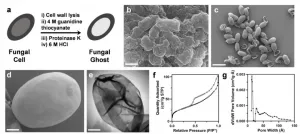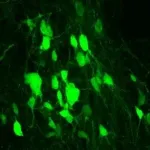(Press-News.org) The idea of creating selectively porous materials has captured the attention of chemists for decades. Now, new research from Northwestern University shows that fungi may have been doing exactly this for millions of years.
When Nathan Gianneschi's lab set out to synthesize melanin that would mimic that which was formed by certain fungi known to inhabit unusual, hostile environments including spaceships, dishwashers and even Chernobyl, they did not initially expect the materials would prove highly porous-- a property that enables the material to store and capture molecules.
Melanin has been found across living organisms, on our skin and the backs of our eyes, and as pigments for many animals and plants. It also plays a role in protecting species from environmental stressors. Turtle-headed sea snakes' stripes darken, for example, in the presence of polluted water; moths living in industrial areas turn black as their cells absorb toxins in soot. The researchers wondered whether this type of biomaterial could be made more sponge-like, to optimize these properties. And, in turn, whether sponge-like melanins existed already in nature.
"Melanin's function isn't fully known all the time and in all cases," Gianneschi, the corresponding author on the study, said. "It's certainly a radical scavenger in human skin and protects against UV damage. Now, through synthesis we've happened upon this exciting material that very well may exist in nature. Fungi might make this material to add mechanical strength to their cells, but is porous, allowing nutrients across."
The study will be published Friday, March 5, in the Journal of the American Chemical Society.
Gianneschi is the Jacob and Rosaline Cohn Professor of Chemistry in the Weinberg College of Arts and Sciences. With appointments in the materials science and biomedical engineering departments in the McCormick School of Engineering, Gianneschi also is associate director of the International Institute for Nanotechnology.
The ability to create this material in a lab is encouraging for a number of reasons. In typical non-porous materials, particles adsorb only superficially on the surface. But porous materials like allomelanin soak up and hold undesirable toxins while letting good stuff like air, water and nutrients through. This may allow manufacturers to create breathable, protective coatings for uniforms.
"You're always excited by discovering something that's potentially useful," Gianneschi said. "But there's also the intriguing idea that by discovering this, maybe more materials like this exist out there in biology already. There aren't many examples where chemical synthesis leads to a biological discovery. It's most often the other way around."
Naneki McCallum, a graduate student researcher in the lab and first author on the paper, had noticed that under the right conditions, melanin appeared to be hollow, or could be made to contain what looked like voids by electron microscopy. When the team came across the synthetic material, they began experimenting with porosity and selectivity of the materials for adsorbing molecules in those voids.
In a key demonstration, the team, working with researchers at the Naval Research Laboratory, was able to show that the new porous melanin would act as a protective coating, preventing simulants of nerve gas from getting through. Inspired by this result, they then isolated naturally occurring melanin from fungal cells. This was done by etching away biomaterial from within, leaving a shell containing melanin. They call these structures "fungal ghosts" for the elusive, hollow shape's "Casper"-like quality. The material, derived from fungi could also, in turn be used as a protective layer in fabrics. Remarkably, the material stays breathable, allowing water to pass, while trapping toxins.
Another benefit to this material is its simplicity, as it's easily produced and scaled from simple molecular precursors. In the future, it could be used to make protective masks and face shields and has potential for applications in long distance space flight. Coating materials in space would allow astronauts to store toxins they're breathing out while protecting themselves from harmful radiation, making for less waste and weight.
It's also a step toward selective membranes, a highly complex field of study that aims to take compounds like water and allow healthy minerals to pass through while blocking heavy metals like mercury.
"Fungi can thrive in places where other organisms struggle, and they have melanin to help them do it," McCallum said. "So, we ask, what are the properties that we can harness by recreating such materials in the lab?"
INFORMATION:
The study was supported by a MURI through the Air Force Office of Scientific Research (AFOSR FA9550-18-1-0142) and the Defense Threat Reduction Agency (HDTRA1-19-19-1-0010).
The paper is titled, "Allomelanin: A Biopolymer of Intrinsic Microporosity."
Using genetic engineering, researchers at UT Southwestern and Indiana University have reprogrammed scar-forming cells in mouse spinal cords to create new nerve cells, spurring recovery after spinal cord injury. The findings, published online today in Cell Stem Cell, could offer hope for the hundreds of thousands of people worldwide who suffer a spinal cord injury each year.
Cells in some body tissues proliferate after injury, replacing dead or damaged cells as part of healing. However, explains study leader END ...
What The Study Did: The objectives of this study were to examine the characteristics and outcomes among adults hospitalized with COVID-19 at U.S. medical centers and analyze changes in mortality over the initial six months of the pandemic.
Authors: Ninh T. Nguyen, M.D., of the University of California, Irvine Medical Center, in Orange, is the corresponding author.
To access the embargoed study: Visit our For The Media website at this link https://media.jamanetwork.com/
(doi:10.1001/jamanetworkopen.2021.0417)
Editor's Note: The article includes ...
What The Study Did: Survey data were used to estimate changes in racial/ethnic disparities in rates of autism spectrum disorder among U.S. children and adolescents from 2014 through 2019.
Authors: Z. Kevin Lu, Ph.D., of the University of South Carolina in Columbia, is the corresponding author.
To access the embargoed study: Visit our For The Media website at this link https://media.jamanetwork.com/
(doi:10.1001/jamanetworkopen.2021.0771)
Editor's Note: Please see the article for additional information, including other authors, author contributions and affiliations, conflict of interest and financial disclosures, and funding and support.
INFORMATION:
Media advisory: The full study is linked to this news release.
Embed ...
What The Study Did: Researchers examined the association of increased anti-immigrant rhetoric during the 2016 presidential campaign with changes in the use of health care services among undocumented patients.
Authors: Joseph Nwadiuko, M.D., M.P.H., M.S.H.P., of the University of Pennsylvania Perelman School of Medicine in Philadelphia, is the corresponding author.
To access the embargoed study: Visit our For The Media website at this link https://media.jamanetwork.com/
(doi:10.1001/jamanetworkopen.2021.0763)
Editor's Note: Editor's Note: The article includes conflicts of interest and funding/support disclosures. Please see the article ...
What The Study Did: In this study, many children and adolescents hospitalized for COVID-19 or multisystem inflammatory syndrome in children had neurologic involvement, mostly transient symptoms. A range of life-threatening and fatal neurologic conditions associated with COVID-19 infrequently occurred. Effects on long-term neurodevelopmental outcomes are unknown.
Authors: Adrienne G. Randolph, M.D., of Boston Children's Hospital, is the corresponding author.
To access the embargoed study: Visit our For The Media website at this link https://media.jamanetwork.com/
(doi:10.1001/jamaneurol.2021.0504)
Editor's Note: The article includes conflict of interest ...
DNA sequencing of bacteria found in pigs and humans in rural eastern North Carolina, an area with concentrated industrial-scale pig-farming, suggests that multidrug-resistant Staphylococcus aureus strains are spreading between pigs, farmworkers, their families and community residents, and represents an emerging public health threat, according to a study led by researchers at the Johns Hopkins Bloomberg School of Public Health.
S. aureus is commonly found in soil and water, as well as on the skin and in the upper respiratory tract in pigs, other animals, and people. It can cause medical problems from minor skin infections to serious surgical wound infections, pneumonia, and the often-lethal blood-infection condition known as sepsis. The findings provide evidence that multidrug-resistant ...
Researchers from the University of Tennessee, Knoxville, have collaborated on two studies examining the socioeconomic factors involved in the spread of COVID-19.
Professor Alex Bentley and postdoctoral fellow Damian Ruck, both from the Department of Anthropology, joined Josh Borycz, a librarian at Vanderbilt University, to conduct the studies.
"One of our studies considers the global scale of nations and the other uses the national scale for US counties to analyze results during 2020," explained Bentley.
The studies show that the numbers of COVID-19 cases and deaths are significantly affected ...
Two thirds of children use more than one screen at the same time after school, in the evenings and at weekends as part of increasingly sedentary lifestyles, according to new research at the University of Leicester.
An NIHR study of more than 800 adolescent girls between the ages of 11 and 14 identified worrying trends between screen use and lower physical activity - including higher BMI - as well as less sleep.
The use of concurrent screens (termed 'screen stacking') grew over the course of the week - with 59% of adolescents using two or more screens after school, 65% in the evenings, and 68% at weekends.
Some teens reporting using as many as four screens at one time.
But further analysis showed the use of any screen was still detrimental to the indicators ...
A new study from the University of Iowa sought to begin development of a possible approach to reduce the risk that college-aged men engage in sexually aggressive acts or risky sexual behavior.
The study authors, led by Teresa Treat, professor in the Department of Psychological and Brain Sciences at Iowa, developed a 12-point list of sexual assault prevention strategies. The list was created by the researchers based on previous research into risk factors that are associated with sexually aggressive acts--such as heavy alcohol consumption, difficulties reading women's cues, and not seeking consent for sexual activity.
The authors found that 71% of the college-aged men surveyed used the sexual assault prevention strategies on a regular basis over the past year. Yet 15% of the ...
DANVILLE, Pa. - A team of scientists from Geisinger and Tempus have found that artificial intelligence can predict risk of new atrial fibrillation (AF) and AF-related stroke.
Atrial fibrillation is the most common cardiac arrhythmia and is associated with numerous health risks, including stroke and death. The study, published in Circulation, used electrical signals from the heart--measured from a 12-lead electrocardiogram (ECG)--to identify patients who are likely to develop AF, including those at risk for AF-related stroke.
"Each year, over 300 million ...

